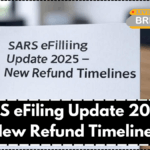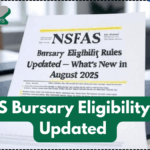The NSFAS Allowance Top‑Up August 2025 is an important update for students who rely on financial aid to cover essentials like food, transport, and accommodation. This initiative ensures that students who faced shortfalls earlier in the year get the support they need to continue their studies without disruption.
Many students have also raised concerns about NSFAS student allowance overpayment situations, where funds were either delayed or disbursed incorrectly. Understanding the new top‑up system, eligibility rules, and how to apply can help students avoid confusion and secure the assistance they are entitled to.

Why the Allowance Top‑Up Is Needed
The NSFAS Allowance Top‑Up August 2025 was introduced after reports of students not receiving their full allowances due to administrative backlogs, system errors, or verification issues. In some cases, overpayments happened, causing deductions later.
The top‑up program aims to correct these discrepancies while ensuring that genuine students do not suffer. Addressing issues like NSFAS student allowance overpayment is part of NSFAS’s larger effort to improve accuracy and accountability.
Who Qualifies for the Allowance Top‑Up
Not every student automatically qualifies for the NSFAS Allowance Top‑Up August 2025. NSFAS has issued clear eligibility criteria to ensure the program supports those who truly need it.
| Criteria | Requirement for Students |
|---|---|
| Active NSFAS Beneficiary | Must currently be receiving NSFAS funding |
| Verified Enrollment | Must be registered at an approved institution |
| Allowance Shortfall | Must have documented proof of underpayment or missing funds |
| Good Standing | No unresolved NSFAS student allowance overpayment cases |
Students meeting these criteria are the ones most likely to benefit from the top‑up.
How to Apply for the Top‑Up
Applying for the NSFAS Allowance Top‑Up August 2025 is straightforward but requires students to submit accurate documents and follow the process carefully.
-
Log into the NSFAS online portal or visit the financial aid office at your institution
-
Submit your student ID, proof of registration, and bank details
-
Provide documentation showing missing or delayed allowance payments
-
Wait for verification and confirmation before funds are released
Students who had NSFAS student allowance overpayment issues must settle those discrepancies first, as unresolved overpayments can delay approval.
How Overpayments Are Being Handled
While the top‑up is designed to help, NSFAS is also tightening control over NSFAS student allowance overpayment cases. Some students accidentally received extra funds, which NSFAS is now reclaiming through adjustments or repayment agreements.
This approach ensures fairness and keeps the system sustainable for all. Students applying for the NSFAS Allowance Top‑Up August 2025 should check their statements to avoid surprises if overpayment deductions are applied.
Conclusion
The NSFAS Allowance Top‑Up August 2025 is a vital safety net for students who experienced allowance shortfalls this year. By understanding who qualifies, how to apply, and how NSFAS student allowance overpayment situations are being resolved, students can get the support they need and keep their education on track.
FAQs
Who qualifies for the NSFAS Allowance Top‑Up August 2025?
Only active NSFAS beneficiaries with verified enrollment and documented allowance shortfalls qualify.
Will NSFAS student allowance overpayment affect my top‑up?
Yes, if you have an unresolved NSFAS student allowance overpayment, your top‑up might be delayed or adjusted.
How long does the application process take?
Most NSFAS Allowance Top‑Up August 2025 applications are processed within two to four weeks.
Can I apply if I already received a full allowance earlier this year?
No, the top‑up is for students with documented underpayments, not those who already received full allowances.
How will I know if my application is approved?
You will receive confirmation via the NSFAS portal or your institution’s financial aid office once the NSFAS Allowance Top‑Up August 2025 is processed.
Click here to know more.



